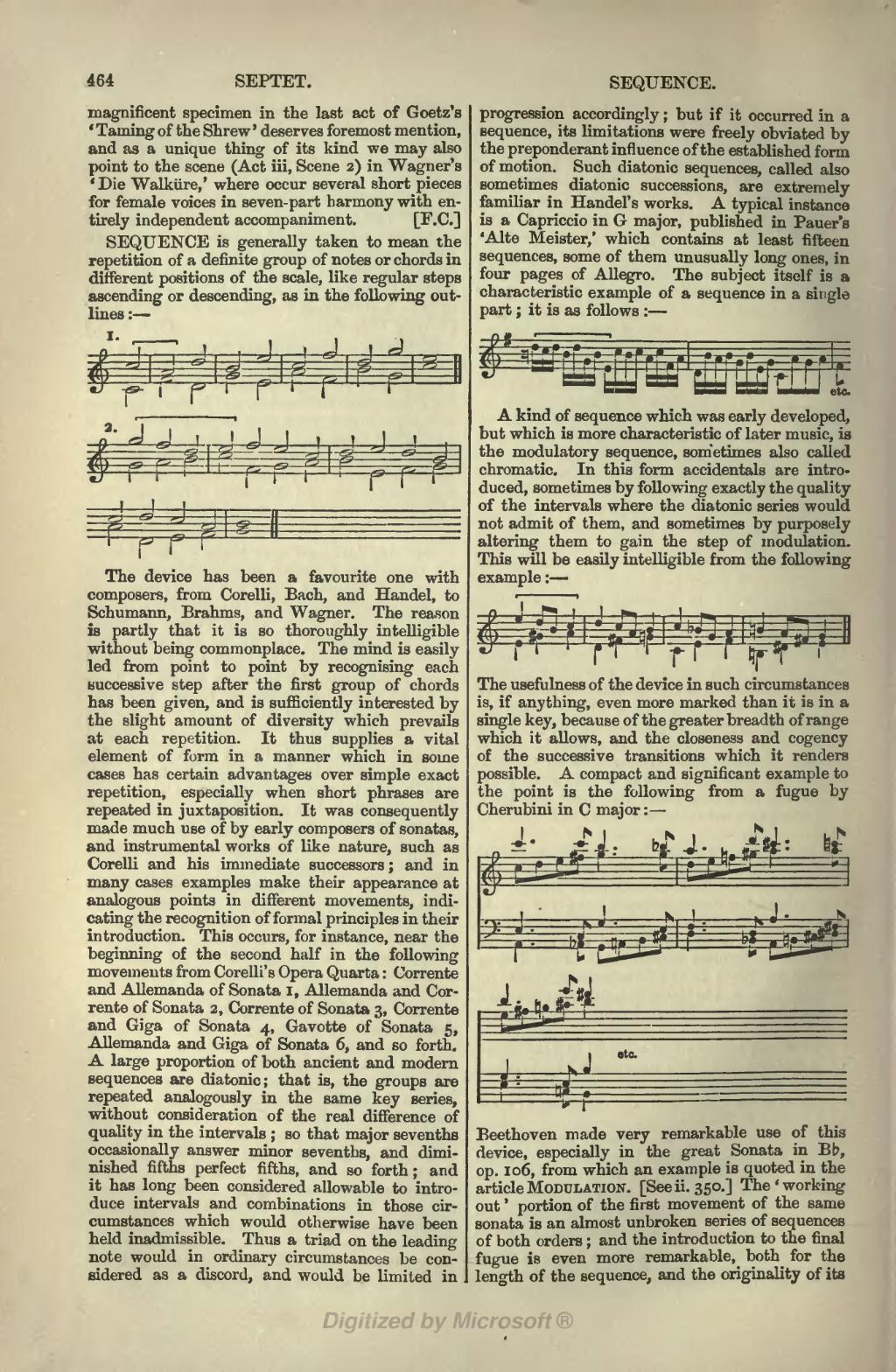magnificent specimen in the last act of Goetz's 'Taming of the Shrew' deserves foremost mention, and as a unique thing of its kind we may also point to the scene (Act iii, Scene 2) in Wagner's 'Die Walküre,' where occur several short pieces for female voices in seven-part harmony with entirely independent accompaniment.
[ F. C. ]
SEQUENCE is generally taken to mean the repetition of a definite group of notes or chords in different positions of the scale, like regular steps ascending or descending, as in the following outlines:—
![{ \new Staff << \override Score.TimeSignature #'stencil = ##f \time 2/2 \partial 2
\new Voice \relative c'' { \stemUp
\[ c2^"1." | a \] d | b e | c f | d g | e1 \bar "||" }
\new Voice \relative c' { \stemDown
c2 | f d | g e | a f | b g | c1 } >> }](http://upload.wikimedia.org/score/j/m/jm5txtwzkjb11h1n2b1ckwdcbw7k3ja/jm5txtwz.png)
![{ \new Staff << \override Score.TimeSignature #'stencil = ##f \time 4/2 \partial 1.
\new Voice \relative g'' { \stemUp
\[ g2^"2." f d | e \] f e c | d e d b | c d c a | b1 \bar "||" }
\new Voice \relative g' { \stemDown
g2 a b | c f, g a | b e, f g | a d, e f | g1 } >> }](http://upload.wikimedia.org/score/k/o/koge55nkgvc5d2rdj4aeo001m906lgl/koge55nk.png)
The device has been a favourite one with composers, from Corelli, Bach, and Handel, to Schumann, Brahms, and Wagner. The reason is partly that it is so thoroughly intelligible without being commonplace. The mind is easily led from point to point by recognising each successive step after the first group of chords has been given, and is sufficiently interested by the slight amount of diversity which prevails at each repetition. It thus supplies a vital element of form in a manner which in some cases has certain advantages over simple exact repetition, especially when short phrases are repeated in juxtaposition. It was consequently made much use of by early composers of sonatas, and instrumental works of like nature, such as Corelli and his immediate successors; and in many cases examples make their appearance at analogous points in different movements, indicating the recognition of formal principles in their introduction. This occurs, for instance, near the beginning of the second half in the following movements from Corelli's Opera Quarta: Corrente and Allemanda of Sonata 1, Allemanda and Corrente of Sonata 2, Corrente of Sonata 3, Corrente and Giga of Sonata 4, Gavotte of Sonata 5, Allemanda and Giga of Sonata 6, and so forth. A large proportion of both ancient and modern sequences are diatonic; that is, the groups are repeated analogously in the same key series, without consideration of the real difference of quality in the intervals; so that major sevenths occasionally answer minor sevenths, and diminished fifths perfect fifths, and so forth; and it has long been considered allowable to introduce intervals and combinations in those circumstances which would otherwise have been held inadmissible. Thus a triad on the leading note would in ordinary circumstances be considered as a discord, and would be limited in progression accordingly; but if it occurred in a sequence, its limitations were freely obviated by the preponderant influence of the established form of motion. Such diatonic sequences, called also sometimes diatonic successions, are extremely familiar in Handel's works. A typical instance is a Capriccio in G major, published in Pauer's 'Alte Meister,' which contains at least fifteen sequences, some of them unusually long ones, in four pages of Allegro. The subject itself is a characteristic example of a sequence in a single part; it is as follows:—
![{ \override Score.TimeSignature #'stencil = ##f \time 4/4 \key g \major \relative d'' {
r16 \[ d c d b d g, b e, \] c' b c a c fis, a |
d, b' a b g b e, g c,8 a' g a | fis s_"etc." } }](http://upload.wikimedia.org/score/l/s/lsoh76bu4f4m8l2d5es2ssak8inmudu/lsoh76bu.png)
A kind of sequence which was early developed, but which is more characteristic of later music, is the modulatory sequence, sometimes also called chromatic. In this form accidentals are introduced, sometimes by following exactly the quality of the intervals where the diatonic series would not admit of them, and sometimes by purposely altering them to gain the step of modulation. This will be easily intelligible from the following example:—
![{ \new Staff << \override Score.TimeSignature #'stencil = ##f \time 3/4
\new Voice \relative e'' { \stemUp
\[ e4 d8 b c4 \] | d c8 a b4 |
c bes8 g a4 | b! a8 fis g4 \bar "||" }
\new Voice \relative e' { \stemDown
e4 gis a | d, fis g! | c, e f | b,! dis e } >> }](http://upload.wikimedia.org/score/l/m/lmmopmojmd1dghk0z4s2rjw2esig3mm/lmmopmoj.png)
The usefulness of the device in such circumstances is, if anything, even more marked than it is in a single key, because of the greater breadth of range which it allows, and the closeness and cogency of the successive transitions which it renders possible. A compact and significant example to the point is the following from a fugue by Cherubini in C major:—

Beethoven made very remarkable use of this device, especially in the great Sonata in B♭, op. 106, from which an example is quoted in the article Modulation. [See ii. 350.] The 'working out' portion of the first movement of the same sonata is an almost unbroken series of sequences of both orders; and the introduction to the final fugue is even more remarkable, both for the length of the sequence, and the originality of its

